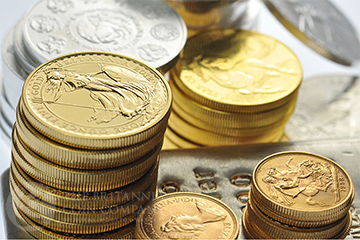When it comes time to sell your proof coins their condition will impact how much you can get for them. Proof coins with milkspots, toning or hairline scratches are not as appealing to buyers and command lower prices than pristine examples.
We're keen to buy all types of proof coins but hairlines will impact the price we can offer.
So what are they? Can you get rid of them? And how can you avoid hairlines on coins?
What Are Hairline Scratches On Coins?
Hairline scratches are shallow, incuse marks on the surface of a coin.
These fine scratches may be visible to the naked eye or under low magnification. Like dinks and abrasions, hairlines are common on circulating coins that clink together in tills and pockets.
Modern proof coinage will quickly develop hairlines with similar treatment though most collectors seek to avoid any damage to the fine mirrored surfaces of their coins. That said, improper handling, well-intentioned storage solutions and attempts at cleaning can all result in hairlines on proof coins. Velvet trays may create slide marks and a quick once-over with a dusting cloth can seriously impact the appearance of these limited edition pieces.
Hairlines should not be confused with die-polishing lines. These lines are raised, caused by the die used to strike a coin being cleaned or re-polished.
How Do Scratches Impact A Coin's Value?
Scratches reduce the value of proof coins.
Reputable dealers will carefully examine collectable coinage using a jeweller's loupe or other magnification equipment before providing a final valuation. For high-end coinage, significant scratches can reduce the price offered by hundreds or even thousands of Pounds. This is because most collectors of modern coinage want their acquisitions to be in mint condition. It's difficult to retail damaged coins so professional buyers may only offer the 'scrap' price for a seriously scratched piece.
Scratches will be considered by coin grading companies when you send your coin for assessment. NGC assigns an adjectival 'Details' grade to scratched coins which will appear on the holder label. This can significantly impact the resale value of a graded coin.
Should I Tell My Buyer If My Coins Have Hairlines?
Your coin dealer will quickly spot hairline scratches on your coins.
When sellers contact us by phone or email, looking for a valuation on their coins, sight-unseen, we provide a provisional quote that assumes the coins are in good condition. The more information you provide at this stage - including disclosing scratches - the more accurate your initial quote will be.
Our final quote is based on assessing your coins in person, taking into account factors like hairlines. We cannot honour provisional quotes for items that are found to have scratches when inspected. You'll be asked to approve your revised quote before payment is issued.
Can Hairline Scratches On Coins Be Removed?
Independent conservators and companies like NGC may be able to remove or improve the appearance of scratches from coins. Experts can also tackle tarnishing, haze, copper spots, milk spots, encrustations and residues that impact the appearance of proof coins and other collectables. These services do come at a cost and the end result is often an improvement rather than a total fix. You will need to balance the price of conservation against the value of the coin.
A quick Google search will turn up a range of guides to cleaning coins at home. We've tested some of these ideas on our YouTube channel, using everything from HP Sauce to Vaseline.
It was a lot of fun to try these home remedies out on some inexpensive coins but we certainly would not recommend using domestic cleaning solutions on coins you care about or want to sell: you may devalue the coin further in the process.
How To Avoid Hairlines On Proof Coins
We've got three key tips to protect your proof coins from hairlines:
- Keep them in their capsules: It's fun to hold a rare coin in your hand but any contact increases the likelihood of scratches developing
- Avoid alternative storage: Display folders or coin trays can be great ways to store some types of collectable coins but not proofs. Inserting and removing coins from albums is a recipe for scratches and even plush velvet can cause friction marks over time
- Avoid home cleaning: Despite what you might read online, Diet Coke won't improve the appearance of your coins. If you want your coins cleaned then get in touch with a professional conservator



